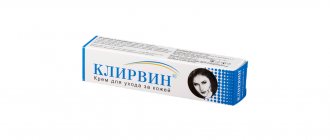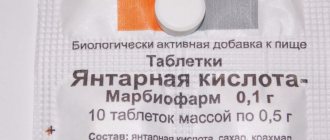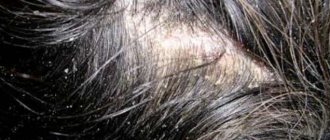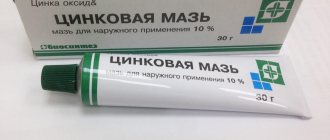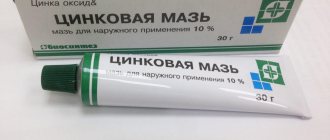Antihistamines are aimed at eliminating allergies in all its manifestations. During their action, the drugs block special receptors that are involved in the development of an allergic reaction. Especially if this is an immediate reaction, where the main role belongs to an organic compound - histamine. Under provoking factors, histamine becomes active in the human body and can lead to such types of allergies as:
- allergic rhinitis;
- allergic conjunctivitis;
- hives;
- angioedema;
- reaction to an insect bite;
- allergies to medications (tablets, sprays, etc.);
- food allergies;
- skin allergies, allergic dermatosis.
Taking an antihistamine (drops, tablets, ointment) in these cases is the first line of treatment. All medications in the form of tablets or drops act on H1 receptors located in the brain, blood vessels, smooth muscles, cardiac tissue, cartilage tissue, etc. [1].
The role of histamine in allergic reactions
Histamine is a biologically active substance produced by the body to regulate vital functions (blood circulation, respiration, digestion). It is concentrated in mast cells, white blood cells that are part of the immune system.
Under normal conditions, there is little histamine in the human body and it is inactive. But when certain substances enter the body, their active production begins. When the allergen binds to immunoglobulin, mast cells degranulate (release substances that cause an inflammatory response). Histamine is released, leaves the cells, and the body comes under its influence. It causes:
- hives;
- swelling of the mucous membranes;
- bronchospasms;
- decreased blood pressure;
- digestive disorders;
- confusion;
- slowing down the conduction of nerve impulses.
The first three reactions are allergic. They are the immune system's response to contact with an irritant. Most allergic reactions develop immediately.
Complex therapy of allergic manifestations during exacerbation
Medical Council, No. 7, 2015
E.N. MEDUNITSYNA
, Candidate of Medical Sciences,
Senior Researcher of the Department of Immunodeficiencies of the Federal State Budgetary Institution "SSC Institute of Immunology" FMBA of Russia
Treatment of exacerbation of allergic diseases is a problem that is solved by a complex of medicinal and non-medicinal measures. Despite a fairly wide range of drugs used to treat exacerbation of allergic diseases affecting various organs and systems, the most commonly used drugs remain antihistamines and glucocorticosteroids. These groups of drugs have the most pronounced clinical effect associated with the pharmacological characteristics of these drugs, which allow them to quickly influence almost all stages of the allergic reaction. In allergy practice, other antiallergic drugs are also widely used - leukotriene receptor antagonists, mast cell membrane stabilizers, etc. The main task of the allergist-immunologist is to choose the correct tactics for managing the patient during an exacerbation, selecting adequate antiallergic therapy taking into account the individual characteristics of the patient, character the course and severity of exacerbation of the disease.
Treatment of allergic diseases is a whole range of preventive and therapeutic measures aimed at stopping exacerbations, as well as preventing relapses and progression of the disease.
Allergy
(Greek
allos
- other and
ergon
- action) - a state of altered reactivity of the body, manifested by an increase in its immunologically mediated sensitivity to various substances of exogenous and endogenous origin - allergens (substances that cause sensitization of the body and allergic reactions - foreign proteins, lipids, mucopolysaccharides, compounds non-protein nature, some low-molecular substances - haptens). Primary contact of the body with an allergen, which can be carried out in different ways - parenterally, inhalation, enterally, through the skin or mucous membranes, in the presence of a genetic predisposition to such a reaction method, leads to sensitization, which in turn is accompanied by the formation of antibodies or sensitized lymphocytes. When the allergen is repeatedly exposed, an immediate or delayed allergic reaction develops, including 3 stages. In the immunological stage, re-entry of the allergen into the body leads to a reaction of allergic antibodies or sensitized lymphocytes with the allergen. In the pathochemical stage, a series of biochemical reactions occur, leading to the release of mediators from the cells. The pathophysiological stage is characterized by the presence of delayed and immediate clinical manifestations. The main pathophysiological changes during an allergic reaction are contraction of smooth muscles, dilation of small vessels and capillaries, and release of fluid into the extravascular space.
There are a number of diseases that are based on the allergic process. Allergic diseases - (Greek allos - other and ergon - action) - a group of human diseases caused by increased sensitivity to exoallergens: allergic rhinitis, allergic conjunctivitis, bronchial asthma, atopic and contact allergic dermatitis, allergic urticaria and Quincke's edema, drug allergies, food and insect allergies, etc. There are allergic nosologies, the genesis of which involves several types of allergic reactions, as well as a group of diseases in which the allergic process is a component of the underlying disease. The clinical picture of allergies depends on the route of entry of the allergen into the body, the type of allergic reaction and the location of allergic inflammation. Allergic diseases occur with damage to the respiratory tract, skin and mucous membranes, cardiovascular and other body systems. The severity of the condition during exacerbation of allergic diseases can vary from mild to extremely severe. Acute reactions, including drug allergies, can lead to severe multiple organ failure.
Treatment
Impact on allergic inflammation involves not only the use of pharmacotherapy, but also the implementation of a number of preventive measures. In the case of mild exacerbations that do not require hospitalization in a hospital, treatment is carried out on an outpatient basis under the dynamic supervision of an allergist-immunologist with treatment correction based on the results of assessing the patient’s condition over time. In case of more severe exacerbations of an allergic disease, the patient is indicated for hospitalization in an allergy hospital or, in cases of acute anaphylactic reaction, status asthmaticus and other life-threatening conditions, in the intensive care unit.
Non-drug methods of treating allergic diseases include measures aimed at eliminating the causative allergen and provoking factors. Elimination of the allergen is a fundamental measure that is used both at the stage of stopping the exacerbation of the disease and in the subsequent period, and should be carried out for any form of allergy. In each individual case, a set of elimination measures is considered: prescribing a hypoallergenic diet, taking measures aimed at eliminating or minimizing contact with medicinal, inhalant, insect, food and other allergens. The duration and effectiveness of treatment largely depends on the timeliness of elimination measures [1].
Pharmacotherapy for exacerbation of allergic disease
During the period of exacerbation of an allergic disease, the correct choice of patient management tactics is paramount. Relief of exacerbation or acute condition and control of allergy symptoms is carried out by a number of medications belonging to different pharmacological groups. The development of an individual complex of antiallergic drugs should be carried out taking into account the clinical picture of the disease, anthropometric data and physiological characteristics of the patient and other parameters.
There is a basic list of medications used to treat exacerbations of allergic diseases. But we must also take into account the fact that in case of severe exacerbations, as a rule, a wider range of medications is used, both symptomatic and aimed at combating systemic disorders, septic and other complications. In case of severe exacerbations with signs of multiple organ failure (including severe reactions to drugs), various means and methods of detoxification therapy and treatment of metabolic disorders are used. In the presence of infectious complications, antibacterial and antimycotic drugs are used, and sanitation measures are carried out. When choosing a drug, its dose and duration of treatment, the effectiveness and tolerability of the drug, the physiological and anthropometric data of the patient, his age, etc. are assessed. When treating an exacerbation of an allergic disease in children and pregnant women, the safety profile of the drugs is also taken into account, special attention is paid to the form of the drug and its dosage [2].
The main antiallergic drugs used during exacerbation of an allergic disease:
1. Histamine H1 receptor blockers. 2. Glucocorticosteroid drugs. 3. Other medications (anticholinergics, leukotriene receptor blockers, antihistamines with membrane-stabilizing effects).
Histamine H1 receptor blockers (antihistamines)
Antihistamines are a group of drugs whose action is mediated by their interaction with histamine receptors on cells and various tissues.
One of the most important mediators of allergies is histamine. Histamine H1 receptor antagonists are structurally similar to histamine and block these receptors by the principle of competition with histamine. The action of antagonists is reversible.
Histamine - 5[2-aminoethyl] imidazole - is formed from the amino acid histidine under the action of the enzyme of the cell cytoplasm - histidine decarboxylase. Histamine is deposited in the granules of basophils, mast cells localized in target organs, and is in a bound state with the protein and proteoglycan matrix of the granules, and has an affinity for the heparin-protein complex of granules of connective tissue mast cells. During an allergic reaction, activation of mast cells and basophils leads to the displacement of histamine from the granules. The pharmacological effect of histamine on the body is mediated through four types of histamine receptors (H1, H2, H3, H4). Localization of H1 receptors is the smooth muscles of the bronchi, arteries, digestive system and bladder, heart and brain. Through H1 receptors, histamine causes contraction of the smooth muscles of the bronchi, stomach, intestines, gall and bladder, vessels of the pulmonary circulation, increases vascular permeability, increases the intracellular content of cGMP, enhances the secretion of mucus by the mucous glands of the nose, causes chemotaxis of eosinophils, neutrophils and enhances the formation of prostanoids (prostaglandins F2, F2, D2, thromboxane, prostacyclin). Clinical manifestations of the action of histamine are: itching of the skin and mucous membranes, blistering reaction, the formation of swelling of the mucous membranes and hypersecretion of mucus in the respiratory tract, bronchospasm, pain, increased production of pepsin, hydrochloric acid in the stomach, a drop in blood pressure, heart rhythm disturbances and a number of other disorders. Currently existing antihistamine drugs are divided into 1st and 2nd generation drugs. According to the form of the drug, antihistamines are divided into systemic (oral and parenteral forms) and local (in the form of products for application to the skin, as well as intranasal agents and eye drops).
First generation antihistamines
The main representatives of the first generation of antigens are chloropyramine, clemastine, diphenhydramine, cyproheptadine, hydroxyzine, quifenadine, mebhydrolin, dimethindene, etc. The drugs can have a blocking effect not only on H1 receptors, but also on the receptors of other mediators, incl. cholinergic receptors and adrenergic receptors, which determines the difference in their clinical effects. Some drugs have antiserotonin (piperidines) and antidopamine (phenothiazines) activity. Some antihistamines have the properties of local anesthetics, have a stabilizing effect on membranes, and quinidine-like effects on the heart muscle, which can be manifested by a decrease in the refractory phase and the development of ventricular tachycardia [3, 4]. First generation antihistamines are lipophilic and have the ability to penetrate the blood-brain barrier. This is due to their sedative effect. In addition, they can complicate the discharge of viscous sputum from the bronchi in the presence of concomitant bronchopulmonary diseases, including bronchial asthma. The effect of first-generation H1-blockers is short-term, which requires repeated use of the drugs throughout the day, and the development of tachyphylaxis dictates the need to alternate different groups of drugs every 2-3 weeks.
The pharmacological features of this group of drugs, although they limit the possibility of their prescription, however, despite the existing side effects, first generation antihistamines are still widely used in allergy practice, including their parenteral forms (clemastine, chloropyramine, diphenhydramine). Indications for parenteral administration of these drugs are acute allergic reactions requiring immediate medical intervention. The parenteral route of administration ensures good bioavailability and rapid onset of action of the drug. This is especially true in the treatment of acute manifestations of allergies: urticaria, Quincke's edema, allergic dermatitis, acute severe forms of rhinitis/conjunctivitis, various forms of drug, food and insect allergies, etc. However, it is also necessary to take into account the fact that with the development of acute allergic reactions accompanied by significant decrease in blood pressure (anaphylactic shock), the use of systemic antihistamines may aggravate hypotension. First generation H1 blockers, due to their ability to block receptors of other mediators, also find their use in patients with allergic diseases, most often allergic dermatoses, accompanied by severe itching, in whom selective action on H1 receptors does not lead to the formation of a sufficient clinical response. In some cases, it is also possible to use local antihistamines of the first generation as part of local medications, in particular, in the form of a gel. Some drugs (antazolin, dimethindene and diphenhydramine) are used as intranasal and skin applications as mono- or combination therapy in patients with allergic rhinitis and pruritic dermatoses.
II generation antihistamines
Second generation antihistamines have a selective effect on H1 receptors and do not block the receptors of other mediators (in particular, acetylcholine, catecholamines, dopamine) and, as a result, do not give many side effects characteristic of first generation H1 antagonists [3, 4]. Compared to first-generation antihistamines, they have a significantly lower ability to penetrate the blood-brain barrier and, accordingly, do not cause or cause very little sedative effect. Due to their longer action, second generation antihistamines have a more convenient dosage regimen and can be used once a day. Tachyphylaxis also does not occur when taking this group of drugs.
Representatives of the second generation antihistamines: acrivastine, azelastine, ebastine, mequitazine, mizolastine, rupatadine, loratadine, levocetirizine, cetirizine, fexofenadine and desloratadine. The last three of these drugs are considered by some experts to be the third generation of antigen drugs that do not have the side effects that are present in the first and second generation antigens. They are pharmacologically active metabolites of H1-blockers and can suppress both the early and late phases of the allergic response [4].
The instructions for some second generation antihistamines also contain information about the precautions associated with taking these drugs. According to the recommendations of the Experts of the European Academy of Allergy and Clinical Immunology on the safe use of antihistamines, the simultaneous administration of drugs that compete with H1-blockers and involve cytochrome P450 in metabolism should be avoided. The cytochrome P450 isoenzyme CYP3A4 is not involved in the final biotransformation of the active metabolites of drugs of the second generation, therefore this group of drugs is characterized by a high safety profile.
Topical antihistamines azelastine and levocabastine belong to the second generation drugs. They have antihistamine, membrane-stabilizing and anti-inflammatory effects. Local antihistamines are characterized by the achievement of sufficiently high local concentrations of the drug at a low dose and the rapid onset of the therapeutic effect (15 minutes after application). The drugs can be used both in monotherapy and in combination therapy of mild forms of allergic rhinitis/conjunctivitis.
Glucocorticosteroid drugs
Glucocorticosteroids (GCS) affect different phases of allergic inflammation. The anti-inflammatory effect is due to a whole complex of effects on allergic inflammation: a decrease in the permeability of the vascular wall, inhibition of the migration of lymphocytes, eosinophils, and monocytes to the site of inflammation. GCS stabilize cell membranes, inhibit the proliferative process, increase sensitivity to β-agonists, and also have an immunosuppressive effect, manifested in the inhibition of T and B lymphocytes.
Glucocorticosteroids are used in different forms - parenterally, orally, as well as in the form of inhalation agents, intranasally, conjunctivally, locally applied to the skin.
The main groups of systemic glucocorticosteroids used in clinical practice: hydrocortisone, prednisolone, triamcinolone, dexamethasone groups. Based on the duration of adrenocorticotropic hormone inhibition after a single dose, glucocorticosteroids are divided into drugs:
- short-acting (24-36 hours) - hydrocortisone, prednisolone, prednisone, methylprednisolone; - intermediate action (up to 48 hours) - triampcinolone; - long-acting (over 48 hours) - betamethasone, dexamethasone.
Pharmacokinetics of glucocorticosteroids are presented in Table 1
.
| Table 1. Pharmacokinetics of glucocorticosteroids | |||||
| A drug | Equivalent dose, mg | Time of maximum plasma content, h | Time of onset of maximum effect, h | T ½ in plasma, h | T ½ glucocorticoid activity, h |
| Cortisone | 25 | 1—2 | 2—3 | 1 | 4—6 |
| Hydrocortisone | 20 | 1 | 2—8 | 1,5 | 8—12 |
| Prednisone | 5 | 1 | 2—8 | 1,5—3 | 12—36 |
| Prednisolone | 5 | 1—2 | 2—8 | 2,5—3 | 12—36 |
| Methylprednisolone | 4 | 1 | 2—6 | 2,5—3 | 12—36 |
| Triamcinolone | 0,75 | 1—2 | 6—24 | 3,5 | 36—72 |
| Dexamethasone | 0,5 | 1—2 | 6—24 | 3—4,5 | 36—72 |
Systemic glucocorticosteroids can be used to treat exacerbation of almost any allergic disease: bronchial asthma, atopic dermatitis, urticaria, Quincke's edema, various manifestations of drug, food and insect allergies. However, with long-term use of GCS, a number of undesirable effects may develop: disturbances in electrolyte metabolism, increased blood pressure, weight gain, the formation of osteoporosis, myopathy, adrenal atrophy, impaired carbohydrate metabolism, etc. Therefore, the decision to use systemic glucocorticosteroids must be justified. During the therapy period, it is important to monitor the patient’s condition and timely prevention of infectious, metabolic and other complications associated with the use of this group of drugs. The use of systemic corticosteroids for allergic rhinitis and conjunctivitis is undesirable due to the large number of side effects that develop as a result of their use. The drugs can be prescribed only for severe allergic rhinitis (conjunctivitis) in a short course and in the complete absence of the effect of complex antiallergic therapy, including topical corticosteroids.
Inhaled glucocorticosteroids (ICS)
are used for basic therapy of moderate and severe bronchial asthma, as well as to relieve exacerbation of bronchial asthma.
Inhaled glucocorticoids include beclomethasone, budesonide, fluticasone, mometasone, and triamcinolone. Inhaled glucocorticosteroids act in minimal doses, have a pronounced local anti-inflammatory effect, and are quickly inactivated. ICS reduce bronchial reactivity and bronchial secretion, potentiate the effect of beta2-adrenergic agonists, and are characterized by low systemic bioavailability. The systemic effect of ICS is minimal, however, it may have clinical significance in case of long-term use of drugs in high doses. As a rule, in case of exacerbation of bronchial asthma, budesonide is used in the form of a solution for a nebulizer (a convenient and effective system for delivering the drug to the lungs). During exacerbation of bronchial asthma, ICS can be combined with the use of systemic corticosteroids, especially with significant bronchial obstruction, which makes it difficult for the drug to enter the lower respiratory tract. However, in the absence of indications for further administration of systemic corticosteroids, the patient is transferred to inhaled drugs. ICS are often used in combination with other inhaled drugs (usually β2-agonists), as well as other groups of drugs with bronchodilator and anti-inflammatory activity. Intranasal corticosteroids
are the most effective drugs in the treatment of exacerbation of allergic rhinitis [5].
The main representatives of intranasal corticosteroids are beclomethasone dipropionate, budesonide, mometasone furoate, fluticasone propionate. The drugs have high local activity, significantly reduce nasal obstruction, secretion of mucosal glands and tissue edema, reduce sensitivity to nonspecific irritants and are more effective than intranasal antihistamines and cromoglycates. The systemic effect of GCS when administered intranasally is insignificant. Intranasal corticosteroids are often used in combination with drugs from other pharmacological groups, incl. in the form of nasal sprays. GCS can also be used in the treatment of allergic conjunctivitis in the form of eye drops or ointments
(dexamethasone, hydrocortisone) for a short course with monitoring of possible complications, incl.
addition of a secondary infection. Topical corticosteroids
are actively used for the treatment of allergic dermatitis. External therapy with GCS is carried out in cases of exacerbation of the skin process, accompanied by signs of severe inflammation, and in the absence of sufficient effectiveness of the use of drugs from other pharmacological groups. There are various dosage forms of topical corticosteroids - lotions, emulsions, creams, ointments. The choice of the form of the drug depends on the area of application, the severity and nature of the skin lesion. When prescribing topical corticosteroids, it is necessary to take into account not only the indications, but also contraindications or restrictions to their prescription - local infectious process of any etiology, trophic changes in the skin, etc. It is also necessary to monitor the side effects of topical corticosteroids, which can be both local and systemic in nature. Topical corticosteroids are classified according to the composition of their active substances, as well as the content or absence of fluoride, and the strength of their anti-inflammatory activity. There are fluorinated (containing fluorine) and non-fluorinated drugs. Non-fluorinated corticosteroids include: hydrocortisone and its derivatives, prednisolone and its derivatives, mometasone furoate, mesipredone, methylprednisolone aceponate. Fluorinated corticosteroids include: dexamethasone, betamethasone, flumethasone, fluticasone, triamcinolone, clobetasol. Often the nature of the skin process requires the prescription of a combination treatment. Combined corticosteroids contain antibacterial and/or antimycotic components and are used in the presence of signs of secondary infection.
Other antiallergic drugs
Antihistamines with a membrane-stabilizing effect
, inhibit both the early and late phases of the allergic reaction, reduce the hyperreactivity of the mucous membranes.
The drugs are indicated for the prevention and treatment of exacerbation of mild forms of allergic diseases. A representative of systemic drugs in this group is ketotifen, which inhibits the release of histamine, leukotrienes and the slow-reacting substance anaphylaxis from basophils and neutrophils. The therapeutic effect develops slowly over 1-2 weeks, the drug has a sedative effect. The use of ketotifen is possible for mild forms of allergic rhinitis, conjunctivitis, atopic dermatitis, and urticaria. Cromoglicic acid is also used to relieve exacerbations of mild forms of bronchial asthma, allergic rhinitis and conjunctivitis/keratoconjunctivitis, as well as to treat food allergies. The drug stabilizes the membranes of mast cells, inhibits degranulation and the release of histamine, bradykinin, leukotrienes, postaglandins and other active substances from them, and blocks receptors specific for inflammatory mediators. Cromoglicic acid can be used by inhalation in the treatment of bronchial asthma, used in intranasal and conjunctival forms, as well as orally (in the presence of food allergies). This drug is intended to treat mild forms of the disease, but is safe and almost completely free of side effects.
Ipratropium bromide, which is an M-cholinergic blocker, is widely used
as an anticholinergic drug Can be used inhalation and intranasally. Suppresses bronchoconstriction in bronchial asthma, reduces the secretion of glands of the nasal mucosa and bronchi. It has virtually no systemic anticholinergic activity. Both short-term and long-term use of ipratropium bromide is possible. Leukotriene receptor antagonists
are a group of drugs, the main representatives of which are montelukast and zafirlukast. The action of leukotriene receptor antagonists is to inhibit leukotrienes involved in the formation of inflammatory reactions in patients with bronchial asthma, incl. in patients with intolerance to non-steroidal anti-inflammatory drugs, as well as in the treatment of seasonal and year-round rhinitis. The drugs are well tolerated and can be used for a long time after the cessation of symptoms as basic therapy.
Conclusion
Thus, the treatment of exacerbation of allergic diseases is a set of measures aimed at treating allergic inflammation and related to medicinal and non-medicinal methods of influence. The use of certain drugs must be balanced and justified. Antiallergic drugs, if necessary, must be combined with other groups of pharmacological agents that enhance the therapeutic effect, as well as stop infectious, metabolic and other complications of an allergic disease. When carrying out therapy, the severity of the exacerbation, the effectiveness and individual tolerability of the drugs, the presence of complications and concomitant diseases in the patient, and the physiological characteristics of the patient should be taken into account. Only an integrated approach to the management of patients with allergic diseases can ensure the best effect from the therapy [6].
Literature
1. Allergology. Clinical recommendations. Edited by R.M. Khaitov, N.I. Ilyina. - Moscow, publishing group GEOTAR-Media, - 2006, - 227 pp., circulation 3000 copies, 15 pp. 2. Kurbacheva O.M., Shvets S.M. Allergic rhinitis and pregnancy: possibilities of modern therapy. Effective Pharmacotherapy, 2013, 18: 74–80. 3. Gushchin I. S. Allergic inflammation and its pharmacological control. - M.: Farmarus Print, 1998. - 251 p. 4. Gushchin I.S., Kurbacheva O.M. Treatment of allergic year-round rhinitis with antihistamines. Attending Physician, 2004, 8: 20-23. 5. Russian Association of Allergists and Clinical Immunologists. Federal clinical guidelines for the diagnosis and treatment of allergic rhinitis, 2013 6. Allergology and immunology. National leadership. ASMOK. RAAKI. "Geotar-Media". - 2009. - pp. 245-250.
What can trigger an increase in histamine?
Allergens are substances that provoke increased release of histamine. Medicine has studied many allergens that can be divided into such groups.
Exogenous infectiousExogenous non-infectiousEndogenousVirusesFoodProtein-containing compounds that make up the cells of the bodyBacteriaPolenFungiIndustrialHouseholdMedicinal
Endogenous allergens are produced by the body itself. They cause autoimmune diseases (attacks of the immune system on healthy tissues).
Exogenous ones enter the body from the environment - through food, plant pollen, house dust. Industrial allergens include a variety of chemicals (dyes, cleaning products, fragrances).
Antiallergic drugs for children
People of any age are susceptible to allergic reactions. Children most often have allergies to food, household chemicals, medications, animal fur and saliva, insect bites, household dust, and pollen. This is largely due to the immaturity of the body and the characteristics of the children's immune system. Therefore, the need to choose a children's antiallergic drug arises with enviable regularity.
Second and third generation antihypertensive drugs are used to treat allergies in children. First generation drugs are not prescribed to this category of patients due to numerous side effects. Antihistamines for children are available in the form of syrup, suspension, tablets, powder, creams and gels, lotions, and rectal suppositories.
Among the most popular antihistamines used in pediatric practice are Loratadine and Cetirizine. In severe cases, the doctor prescribes hormonal anti-inflammatory drugs.
Symptoms of an allergic reaction
A wide range of symptoms is known, but this does not mean that the same clinical picture occurs upon contact with all allergens. Depending on the type of hypersensitivity, the body reacts differently:
- atopic: rhinitis, conjunctivitis, dermatitis, asthma, Quincke's edema;
- reagin: inflammation of the mucous membranes, autonomic disorders;
- cytotoxic immune: damage to cells and tissues (immune thrombocytopenia, hemolytic anemia, etc.);
- immunocomplex: inflammation of joints, kidneys, skin manifestations.
There are also delayed-type reactions that do not make themselves felt immediately upon contact with the irritant. After two days, the allergen combines with lymphocytes, which leads to the development of an infectious-allergic disease, for example, chronic neurodermatitis.
Allergy treatment
Allergy symptoms are similar to those of skin, colds and other diseases, so it is strictly not recommended to self-medicate and take antihistamines uncontrollably. To select adequate therapy, you need to contact an allergist-immunologist. The doctor conducts special testing, which allows you to establish an accurate diagnosis and determine a list of irritants.
Treatment of allergies consists not only of taking antihypertensive drugs, but also of adjusting the diet, refusing to use products that contain allergens, and changing lifestyle.
How to eliminate allergy symptoms
The more free histamine is released, the more severe the allergic reaction. In some cases it causes inconvenience (constant sneezing, itchy eyes), in others it poses a threat to life (with bronchospasm a person cannot breathe). You can stop the reaction:
- stopping contact with the allergen;
- neutralizing histamine with an antihistamine;
- symptomatic therapy (for example, inhalation to immediately expand the lumens of the bronchi).
In the event of the development of anaphylactic shock, accompanied by a decrease in blood flow and laryngeal edema, it is important to promptly eliminate the threat to life. The set of measures includes the administration of adrenaline and ensuring air flow into the lungs (intubation).
Types of antihistamines
First-generation drugs could block histamine receptor signals only after penetrating the barrier between the circulatory and central nervous systems. As a result, the effects on the central nervous system could not be avoided. Because of this, antihistamines caused drowsiness and loss of coordination.
Pharmacologists took this shortcoming into account when creating second-generation drugs. They do not penetrate the mentioned barrier, act selectively, and do not have a sedative effect.
Third generation antihistamines are metabolites of their predecessors. They give the same effect at a lower dosage and do not affect the functioning of the cardiovascular system. However, some allergists and immunologists do not agree with separating them into a separate group and classify them as the second generation.
In 2015, the Consensus working group on new generation antihistamines led by Professor S.T. Holgate concluded that none of the existing drugs can be classified as third generation.
Examples of AGPs of different generations
AGP 1st generationAGP 2nd generationAGP 3rd generation*DiphenhydramineLoratadineCetirizineTavegilClaritinZyrtecSuprastinKestinCetrinDramamineVisin and Tizin AllergiTelfastDiazolinAllergodilFexofenadineAtarkcFenistilAllerfex
*according to supporters of their existence
Combined ointments
There is a group of combination drugs that contain substances from individual pharmacological groups. Often these products contain an antibiotic or antifungal components, which can have additional effects.
These drugs include Levosin and Oxycort. Antibacterial and anti-inflammatory agents are used as active substances in Levosin. contains antibacterial substances and a glucocorticosteroid.
Features of the action of antihistamines
First generation antihistamines are not limited to suppressing the activity of the central nervous system. They block receptors for various neurotransmitters, not just histamine, and therefore have a number of side effects:
- increased heart rate;
- nausea and vomiting;
- increased eye pressure;
- stomach pain;
- urinary disturbance;
- dry mucous membranes.
With prolonged use, the patient may lose weight, become overexcited, and lose consciousness. In case of overdose, convulsions are possible.
Second-generation antihypertensives act more selectively, and therefore their use does not cause undesirable reactions from organs other than the heart. Patients should consider the risk of sinus and reflex tachycardia, as well as arrhythmias.
The mechanism of biological action of histamine
Biologically active histamine, released from mast cells, has systemic and local effects on the body, namely:
- cause spastic contraction of the smooth muscle layer in the bronchial and intestinal walls, which causes diarrhea, intestinal spasms, spastic respiratory failure;
- stimulates the production of the stress hormone adrenaline by the adrenal cortex, which stimulates cardiac function (increasing blood pressure and heart rate);
- stimulation of the secretory function of the digestive and respiratory systems;
- vascular effect, manifested by the narrowing of large-caliber blood vessels and the expansion of medium and small arteries;
- increasing the permeability of the vascular wall and capillary network.
Vascular reactions lead to the appearance of symptoms such as swelling of the mucous membranes of the respiratory system, the skin with the appearance of small papular rashes, hypotension and accompanying headaches and dizziness.
With a massive release of histamine into the bloodstream, a sharp drop in blood pressure may occur, leading to collapse, which is accompanied by loss of consciousness, tonic-clonic convulsions, vomiting and involuntary defecation and urination. This condition is called anaphylactic shock and requires resuscitation measures.
Antihistamines and the stomach
Histamine itself activates the production of gastric juice. Therefore, there is an opinion that blocking it inhibits secretion. This is not entirely true. H1 blockers are used to relieve symptoms of an allergic reaction. H2 blockers can reduce the production of gastric juice:
- Cimetidine;
- Ranitidine;
- Famotidine;
- Roxatidine.
This is another group of antihistamines used to treat gastritis, gastric ulcers, and reflux esophagitis. Allergy sufferers do not use them. Therefore, there is no risk of disrupting digestion in an attempt to combat hives or conjunctivitis.


